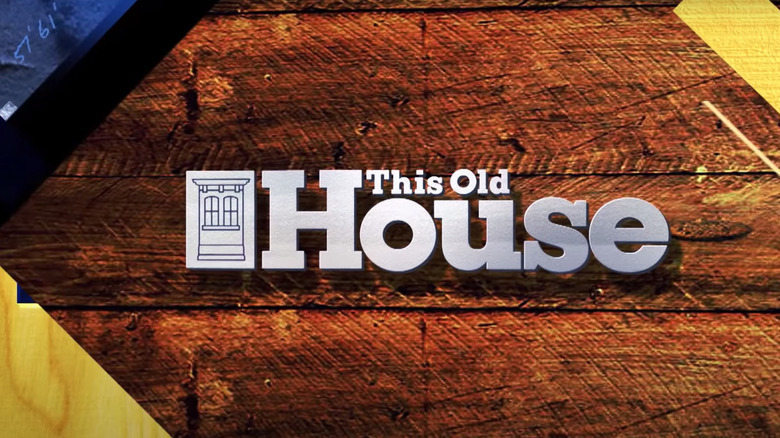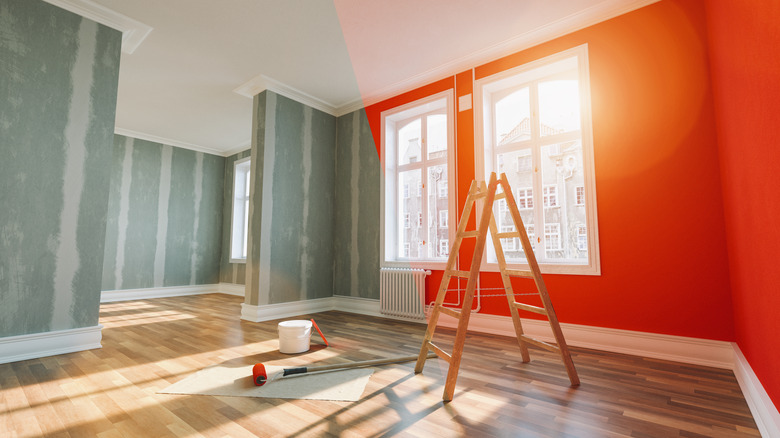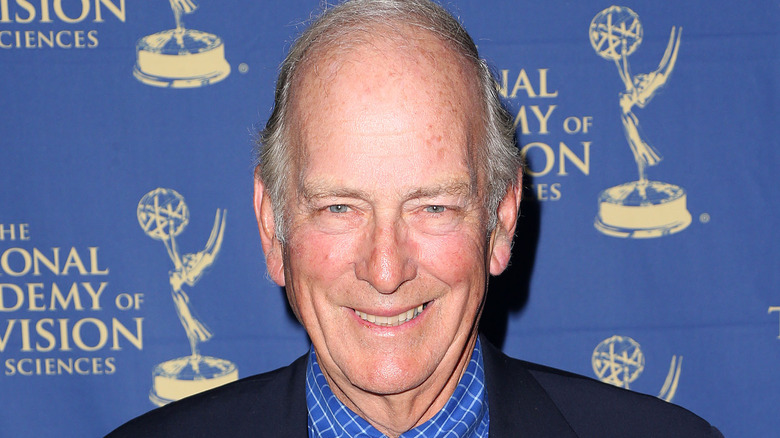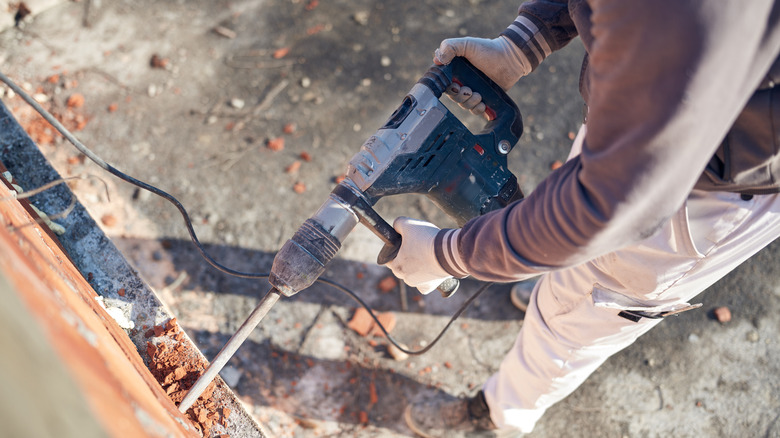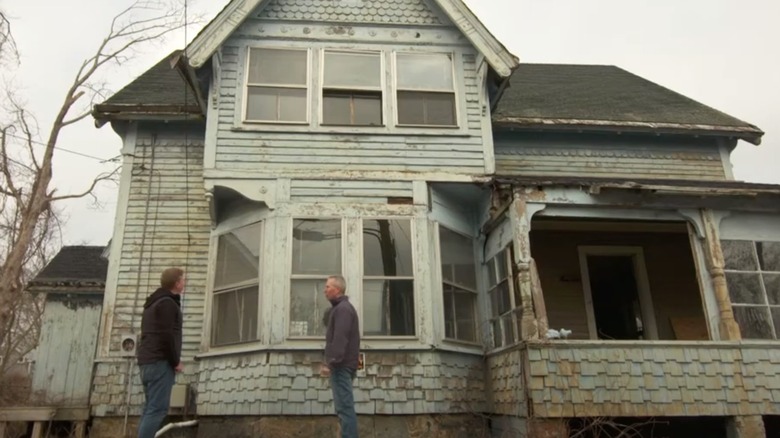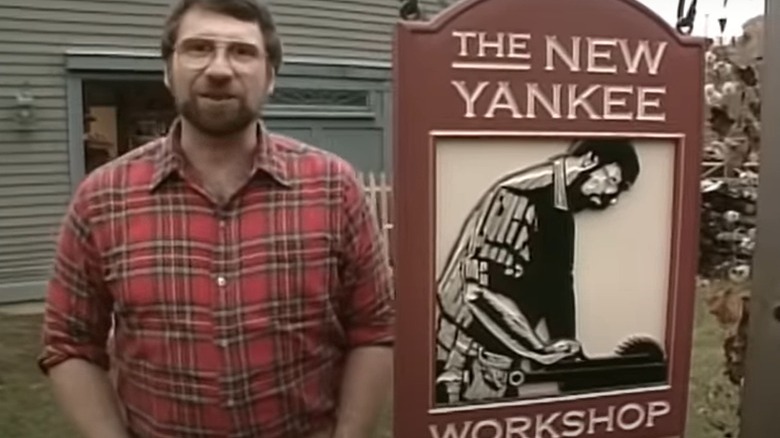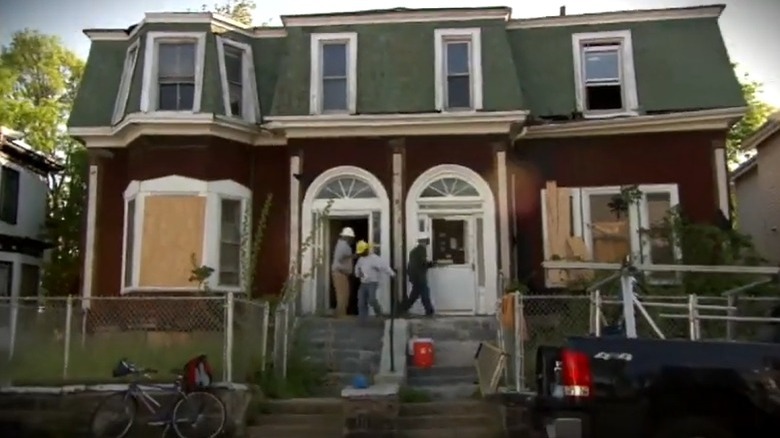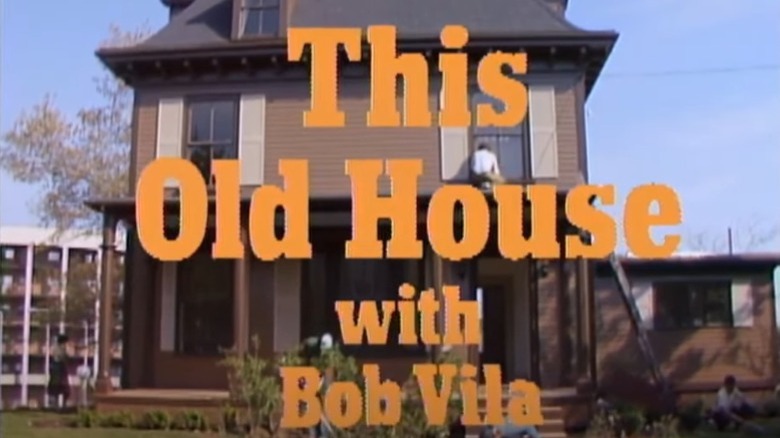This Old House Facts Only Huge Fans Know
"This Old House" is a long-running television show that focuses on the home renovation process. The team typically selects two homes to showcase per season. More than 40 seasons have aired since 1979, per KPCC. During their renovations, professionals guide viewers through the process of making key home improvements. They distill essential knowledge into bite-sized chunks, allowing the average person to feel confident in their own handiwork — perhaps even striking out to make changes to their own property. Creator Russell Morash launched the show and initially aired in the local Boston television market. However, things quickly picked up, and the program eventually became a national phenomenon, with more than one spin-off series produced in the wake of that first season.
"This Old House" is one of the best-known home improvement shows on TV. Its staying power after all these years gives viewers trust in the presenters and team that might not exist otherwise without the long and storied history of the program. While it might seem that the production and continuity of "This Old House" are simple, there are some unique features of the show that viewers might find interesting. These facts add depth to their experience while watching the impressive improvements that host Kevin O'Connor and his team facilitate in everyday homeowners' lives and properties.
This Old House is the original home improvement show
"This Old House" was one of the first home improvement shows to hit television. The New York Times reports that the program is likely responsible for the rise in DIY efforts in homes across the country. The series tackles all the exploits of a professional team of contractors, carpenters, electricians, and plumbers, giving homeowners an inside look at what it really takes to complete these tasks. As a result — and in concert with the introduction and expansion of consumer internet access — content surrounding the home improvement process has exploded in the decades since "This Old House" first made its way into the homes of viewers. Today, homeowners seeking to renovate their kitchen can Google all the topics they are considering for the space, from tile replacements and appliance upgrades to new cabinet installation and granite countertops.
For many, these searches will bring up videos and step-by-step guides on all the different processes involved in removing old materials and preparing the space for installing something fresh and new. In numerous instances, these guides will be either direct video and article content taken from the "This Old House" brand or a repackaging of their framework.
"This Old House" has become essential to the home improvement industry. Simply put, the program has transformed how people think about their space and created significant change in the contracting industry. In prior decades, homeowners might not have thought much about changing the footprint or aesthetic of their homes. However, spendings in the renovation space have slowly and steadily ticked upward through the years, with a difference in spending of nearly $120 billion between 1995 and 2019 (via the Joint Center for Housing Studies – Harvard University). Thanks to the show's success and longevity, the world of home improvement and homeownership is fundamentally reimagined.
The series has won numerous awards and nominations
In addition to its long and storied history, "This Old House" has won 17 Emmy Awards and 82 nominations. Wins include Emmys for Outstanding Lifestyle Program, Outstanding Instructional and How-To Program, and Outstanding Directing in a Service Show, per IMDb. These accolades only serve to boost the stature of the show even further. With directorial, hosting, and general awards earned throughout the years, it's easy to see why so many people love the program and take inspiration from the projects showcased in its numerous episodes.
"This Old House" is a stalwart competitor for award nominations. Not only has the cast and crew won over a dozen times, but the show has seen almost no gaps in nominations since its first honor in 1983. The consistency with which "This Old House" provides intelligent information and high-quality production value to its audience is virtually unheard of in any entertainment area, not just within its niche space of home improvement TV.
"This Old House" always performs, and the people who watch the program to gain more comprehensive knowledge about their property and lifestyle are numerous. The audience demand for "This Old House" is 12.6 times the average for all television series in the United States over the last month, placing it in the top 2.7 percent of all shows on TV (via Parrot Analytics). Similarly, the quarterly magazine has readership numbers of 5.3 million (via This Old House 2021 Media Kit). The audience and accolades go hand in hand. "This Old House" is a powerhouse at delivering essential information in a format that's easy to digest and use in routine life for homeowners across the United States.
The show has humble origins
"This Old House" was created by Russell Morash, a Boston area cameraman, producer, and director. He is known in television circles for starting a working relationship with Julia Child while promoting her cookbook "Mastering the Art of French Cooking" in 1962, per WGBH.
He would continue working with her for over 30 years on various projects in the cooking television space. While Morash was building the foundations of an impressive career, he was also working to improve the bones of his own home. In 1976, he had the idea of bringing together home improvement professionals to chronicle the types of struggles he was working through on his property (via This Old House). In addition to Morash's own home improvement projects, he was interested in other construction jobs. He once drove past an active job site in the dead of winter. Here, he witnessed a surprising scene with numerous people trying to watch the progress of the construction team (via The Biography).
At any rate, fragments of this topic were floating around Morash's mind for several years before he crafted a fully formed idea to place contractors in front of a camera rather than in the shadows of a construction site. The project became — as we know — a hit success, but in the beginning, it wasn't so clear that this would eventually be the case. No one had really gone all in on this type of format before, and skeptics were unsure of the value that plumbers, carpenters, and electricians would bring to a television program. However, the show, originally airing just in the Boston area, quickly picked up steam as it became clear that the production team, headed by Morash, had tapped into something of immense value that consumers wanted. The rest is history.
The first home on the show was a vacant property in Dorchester
Unlike other shows that have come to dominate modern home improvement television, "This Old House" began its run with a vacant property in Dorchester, Massachusetts. According to The New York Times, the first season of "This Old House" centers on restoring a Victorian-style house in Massachusetts that was left vacant and run down. The network bought the property specifically to facilitate the show taping and later sold it. More than 100 people made appointments to see the property when it was listed (via Curbed).
This first home was a proving ground for the concept, and the project is nothing like the format of home improvement television that exists today. Viewers are now familiar with seeing renovations take place against the backdrop of a family struggling to make the features of their home work for their specific needs. Embattled homeowners reach out to professionals who, in exchange for their services and expertise, film the fast transformation and present the lessons learned to a captive audience.
While "This Old House" now follows the team through two real homeowners' properties, the show essentially launched the genre with a dilapidated home that needed restoration. The 1982 season also showcased a homeowner in the process of restoring a similar property in Arlington, Massachusetts, rather than the owner's primary residence.
Bob Vila was the original host
Bob Vila was the face of "This Old House" for 10 years. He left the show in 1989 to pursue other career opportunities (via CNBC). He has since launched his own website and brand and appeared on television and in print. Vila even stepped in as a guest star during the 1990s hit TV show "Home Improvement with Tim Allen" (via IMDb). However, the separation wasn't as rosy as a glossy history of the program might project. Vila was pursuing other opportunities before his time with the show ended because his earning potential quickly surpassed his salary as a television host (via Chicago Tribune).
Vila was part of the charm in the early days of "This Old House," and fans and producers loved his expertise. However, after 10 years on the broadcast, his star power expanded. He was seeking new opportunities to promote sponsored brands and earn a greater income level. As his relationship wound down with "This Old House," tensions were rippling under the surface from the natural cap on funding for the public television series. Vila eventually made an appearance as a direct competitor, tying the hands of the show's executive team and forcing the host out.
Steve Thomas replaced Vila and stayed with the program until 2003 (via IMDb). Kevin O'Connor then took over and continues to host the present-day incarnation of the program (via This Old House). Even with the financial conflict that was taking place early on in "This Old House"'s backstory, it's surprising and comforting for viewers that the brand managed to find great talent to lead the team and hold on to those personalities for such long periods of time. Maintaining long relationships with hosts has instilled much confidence and comfort among viewers.
Contractors thought the show would hurt business
One of the main concerns that "This Old House" brought along with its meteoric rise was the issue of trade secrets. Contractors, plumbers, electricians, and other skilled laborers were initially wary of the program because it shed light on many practices and workflow elements for the homeowner. According to The Atlantic, these trade nuances were teachable moments for the homeowner on the show. However, cluing in homeowners about specialized practices and workarounds to provide code compliance was a potential threat to the need for specialized tradespeople. With enough content, homeowners could theoretically do away with contractors altogether, leaving construction specialists as a relic of pre-internet and cable TV society.
Contractors were not wrong to be worried. A combination of DIY accessibility and cheaply crafted, flat-packed furniture from the likes of IKEA have combined to warp homeowners' natural capacity to appreciate and value the work of skilled builders and other tradespeople (via The Honest Carpenter on YouTube). "This Old House," as a forerunner to the world of televised home improvement, opened the door to this expansive knowledge and scared many within the industry.
Yet, the program has inevitably accomplished two things in tandem. "This Old House" has empowered homeowners to engage in routine maintenance and enhancements to their property that might otherwise go unnoticed and unimproved. It also instills an appreciation for the technical skill and expertise of professionals in home building and renovation. "This Old House" breathed life into the home improvement sector, sparking an explosion in work throughout the trades.
This Old House uses a script for each episode
One feature many viewers might not know or even think much about is that a loose script is created for each episode to keep the narrative and interactions on track. The Biography reports that the host and homeowners that appear in front of the camera have scripts. Written scripts help keep homeowners (who might not be comfortable in front of the camera) work with professionals and create the best possible experience for viewers. Likewise, many homeowners — both those appearing in "This Old House" seasons and viewers at home — don't know what they need to be asking their contractor, plumber, or roofer. A script helps create the kind of dialogue that will make everyone involved a more knowledgeable homeowner.
Another key feature of the scripting process is the show's early efforts to avoid brand placement. In the first seasons of "This Old House," producers were careful about showing or naming brands that were used (or purposefully not used) in their episodes. They did this primarily to avoid copyright issues or libel disputes that a giant manufacturer or supplier might levy against the team.
Many Americans love their tool brands. There's a natural desire to amass a collection of one brand over others to increase the utility of a toolbox. Naming or shaming a brand might create unintended consequences among captive audience members. As a result, the creators carefully removed visual branding or mentions of product manufacturers as best they could to provide a smooth experience for everyone.
The selection process involves considerable research and deliberation
"This Old House" receives thousands of applications to showcase homes each season. According to The Philadelphia Inquirer, this number is often as high as 5,000 every cycle. However, the program only selects two homes per season to feature, making the selection process deliberate and lengthy for anyone who is ultimately selected to participate in the program's taping. On top of detailed descriptions of the home, project scope, and the people in the property, the cost of renovations is borne by the homeowners themselves and not the showrunners or network (via The Washington Post).
Homeowners and fans of the show are encouraged to apply to appear in new seasons of "This Old House," but it's important to remember that a rigorous selection process lies ahead for anyone considering participation. The team is always on the lookout for projects that are interesting, but also showcase common or prototypical issues that other homeowners might face in their own houses. Similarly, a project scope that isn't completely out of reach is crucial to being selected through each round of cuts as the producers narrow in on their chosen homes for the next season.
Producers want to know about the building, the homeowners, and plans and budgeting estimates for engaging in the renovation. All this forms the basis for a feasible timeline and effort, which the show prizes above blockbuster renovations that are big, loud, and ultimately may not be very helpful or desired within the property. "This Old House" is a show that's always been careful about home selection and project scope because it's remained true to its roots: A program that wants to teach homeowners about the rigors, pitfalls, and ultimate triumph of home improvement.
Homeowners pay for the renovations, not This Old House
If you've been dreaming about having your home featured on "This Old House" so you can get some major renovations done, don't get too excited just yet. The homeowners, not the show or its production company, are responsible for paying for the work done to their property. Before you consider applying, you'll want to ensure you have sufficient funds to cover whatever you want to have done to your home.
There are some benefits, however, beyond the opportunity to be on television. Because many manufacturers want to have their products showcased on the program, they are often willing to offer them for a significant discount. Some may even donate a few items. This can help you complete your projects for less than you may have thought they'd cost. However, if any items are donated for your project, you will be responsible for paying taxes on them because they are considered gifts by the IRS.
This Old House has had a few spinoffs
The popularity of "This Old House" made it a prime candidate for spinoffs, seeking to tap into its dedicated fan base. Over the more than four decades that the show has been in production, there have been several spinoffs. One of these was "The New Yankee Workshop," which first aired in 1989. The show, hosted by Norm Abram from "This Old House," sought to share furniture-making skills and techniques with viewers.
"Ask This Old House" is another spinoff from the original series and was released in 2002. The program, which is still in production, is hosted by Kevin O'Connor, Tom Silva, Richard Tretheway, and Roger Cook. During each episode, the expert hosts visit various homes around the country, seeking to help homeowners get the answer to their home improvement questions and problems.
"Inside This Old House," a spinoff that ran for just one year from 2003 to 2004, was also hosted by Kevin O'Connor. During the show, O'Connor and various experts discussed important home improvement topics and looked back at what past homeowners from "This Old House" had done or changed with their homes since being featured.
Yet another spinoff, "This Old House: Trade School," first aired in 2017, with new episodes still being produced. Also hosted by Kevin O'Connor, this show offers detailed directions for various home improvement-related areas, including masonry, plumbing, engineering, and architecture. The professionals share their step-by-step approaches to completing a project, along with some of their favorite tips and tricks.
Roku bought This Old House in 2021
In 2021, Roku purchased "This Old House" from TZP Group. The deal, which is believed to have cost Roku nearly $100 million, gave the streaming platform ownership of a library of over 1,500 episodes of "This Old House" and "Ask This Old House." It also took ownership of new episodes of both programs, which are added onto Roku shortly after they premiere on PBS. They are available to watch on-demand. Once the deal was finalized, Roku also became the owner of the production studio, its digital assets, social media, web pages, print material, and podcasts.
While Roku owns the rights to the episodes, it doesn't appear that it will limit them to being shown only through its streaming service. "We don't need it to be exclusive for it to provide value to us," Rob Holmes, Roku's VP of programming, told Variety. Great news for those who have PBS!
This Old House celebrated its 30th season by working with a nonprofit
The first episode of "This Old House," which aired in 1979, was filmed in Boston, Massachusetts. Thirty years later, the show decided to commemorate its anniversary by returning to Boston to complete a renovation for a community in need. The hosts worked with Nuestra Comunidad, a local affordable housing nonprofit organization, to restore an old 1870s home in the Roxbury neighborhood. Many families in this neighborhood had suffered terrible losses and home foreclosures following the financial crisis just a few years before.
The goal of the project was to get the building's two individual units restored and ready to sell to two families in the area who were in need of housing. What made the project even more interesting was the historical architecture of the property, which the crew worked to bring back to its original beauty — either by restoring what was salvageable or by carefully replicating some of the other aspects, like the plaster ceiling medallions.
This Old House has had three theme songs
In its over four decades on the air, "This Old House" has had three different theme songs. The first theme song was called "Louisiana Fairy Tale." Fats Waller, a jazz musician whose piano compositions are in the Grammy Hall of Fame, performed the song. This was the series's longest-running theme song; it stuck around through Season 23, more than half of the show's lifespan.
The first episode of Season 24 aired with a new theme song. This time, instead of the jazz style of the original theme, the song had a big band swing feel to it. The new theme song, "This Old House 97," was used for about 10 years before it was replaced. The new theme song was written by Bill Janovitz. It offers a more modern feel with its guitar-based melody. Currently, the theme written by Janovitz is still being used on new episodes of the show. Who knows when or if it too will get replaced by something new.
